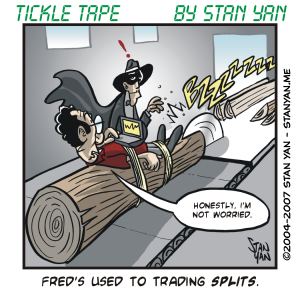How would you prefer to spend your weekend? Would you like to go skydiving or visit the museum? If you fit the stereotype of a short-term trader, you would prefer to go skydiving to the museum. But stereotypes may be inaccurate. If you are disciplined and careful with your money, you may very well prefer the museum. It all depends on your personality. Some people seek out risk, while others prefer security and certainty. People with both kinds of personality styles can learn to trade. It’s just a matter of finding the right fit between your personality style and your trading style.
How much safety have you preferred throughout your life? When you were in high school, were you nervous on dates? Were you afraid to take a risk? Did you try to keep a low profile? The extent to which you seek out risk or run from it may go back to your early childhood. Some parents provided such a safe and secure environment that their children had no fear of venturing out into an uncertain world. Other parents were absent emotionally, and their children were fearful and anxious about what they might have to cope with. These early experiences can continue to influence adult decisions.
This isn’t to say that just because you were fearful as a child that you would be risk-averse as an adult. It’s possible to overcome your early childhood experiences, but it isn’t easy. It’s possible that under enough stress, especially the extreme stress in the trading arena, you could revert to your childhood personality. You may have a deep-seated tendency to avoid the risk that is unexpectedly stifling you in the heat of battle.
In the end, the only way you can determine your tolerance for risk is to gain experience with the markets. Some people have little difficulty risking large amounts of money. They make big trades and take losses in stride. Other people have trouble taking even a minimum amount of risk and prefer long-term investments. No matter how they try to overcome their anxiety about risk, they cannot.
If you find financial risks difficult to handle, you’ll feel calmer if you minimize risk. Some basic ways of managing risk are to have a well-formulated trading plan. Determine how much risk you are taking upfront and decide if you want to actually take that risk. For example, you could look at the fluctuation in price for the past two months (if you are a swing trader, for example) to estimate what the change in the next week or two might be. You could also make sure you use protective stops to minimize risk. And you could risk only a small portion of your account on a single trade.
If you truly feel that risk is at a minimum and bearable, you will feel safe and relaxed. If you still feel a little uneasy, you might have to restrict your trading to long term investing. Long term investing is less risky if you choose a stock that is likely to go up over the long term. As long as you don’t look at it every day, and get bothered by the daily or weekly fluctuations, you’ll forget about your investment and more calmly wait for the price to go up over the long haul. You will feel safe and secure since you can easily convince yourself that the price will eventual reach your target objective if you wait long enough.
Your trading personality may dictate how you trade, but it does not need to dictate whether you should trade. As long as you assess your personality, and match your trading style to your personality, you will feel calm and secure. And when you feel relaxed, you’ll think rationally and decisively, increasing your chances of success.


